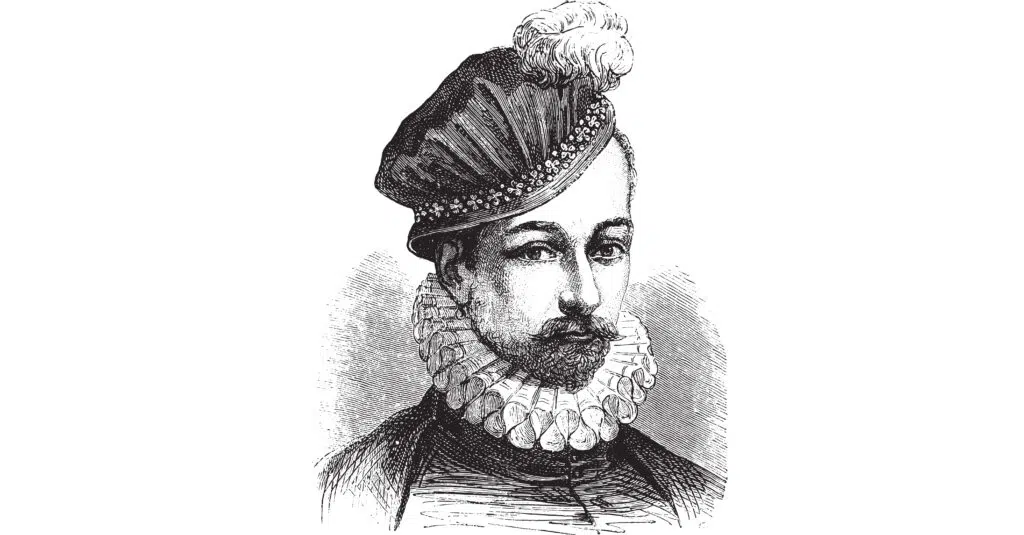Jean Ribault came to fame as a French naval officer, navigator, explorer, and colonizer of what we know nowadays as the southeastern United States. A proud Huguenot, Ribault was heavily involved in colonizing modern-day Florida, leading an expedition to the New World in 1562 which resulted in the founding of Charlesfort on Parris Island, which he named after King Charles IX of France. Two years later, he took over the command of the French colony of Fort Caroline where Jacksonville is currently located.
For Jean Ribault’s expeditions to be a success, he needed the backing of the French leaders of the time, who were strongly Catholic. Not only did he need their blessing but he also needed the financing and logistical support that he could only receive from the French monarchy to set up Huguenot colonies in the New World. In a time when religious beliefs were driving a wedge between the French people, this was no easy task. Charles IX King of France, a strong Catholic, was going to need to be convinced to fund, support, and stand behind sending a Hugeonot-led mission to the New World during a period when tensions between Catholics and Huguenots in France were at an all-time high.
Charles IX’s Accession To The Throne
As the third son of King Henry II of France, Charles XI was originally given the title of Duke of Angouleme before being made Duke of Orleans after his older brother died in infancy. His father died in 1559 with Charles’ older brother becoming King Francis II but he passed away a year later in 1560. This placed Charles as the next in line to take over the throne, and at just ten years old, he was proclaimed King of France on the 5th of December, 1560. However, due to his young age, it was his mother, Catherine de Medici, who was appointed regent and made all administrative decisions throughout his reign.
A Country In Religious Unrest
Unfortunately for Charles, he had inherited a kingdom that had become incredibly divided between the Protestant French Huguenots and the Roman Catholics in the country. In 1560, a group of Huguenot nobles had put a plan in place to abduct King Francis II, Charles’ older brother, and to capture other prolific French Catholic leaders. However, the plot was uncovered ahead of time and the Catholics were prepared. Hundreds of Huguenots were executed for their part in the failed attack.
Although he and his mother made several attempts to establish peace between the two religious groups, their efforts failed. Charles’ mother, Catherine, strived for reconciliation at the Colloquy at Poissy, a religious conference held in 1561 that aimed to establish peace between protestants and Catholics in France.
Despite their efforts, the Catholic Duke of Guise, along with his troops, killed and wounded more than one hundred Hugeonot worshippers in what became known as the Massacre of Vassy. This event brought France closer than ever to civil war and is often referred to as the first major event in the infamous French Wars of Religion, a bloody and violent civil war that consumed France for thirty-six years.
Huguenots Seek Refuge
One of the military commanders of the Protestant party was a man named Gaspard de Coligny, who was naturally at the service of the King of France. However, after being made prisoner at the Siege of Saint Quentin, he converted to Protestantism, also known as the Reformed Faith, and went on to fight against the French Crown. Coligny aimed to establish colonies overseas where French Hugeonots could seek refuge from the persecution of the Catholics.
In 1562, Jean Ribault received the support he needed when Huguenot leader Admiral Gaspard de Coligny received a commission from Charles IX, the King of France, to establish a colony in the New World. The King wanted Ribault to establish a colony for French Huguenots who were being persecuted by the Catholic majority in France at the time. He believed that planting French settlers in Florida would help to defuse the religious conflicts that were taking hold in France and that these colonies would also enable the French Crown to strengthen its claim to part of North America. Finally, Charles IX also sought to find gold, silver, and other precious metals and stones, just as the Spanish had done on their expeditions to South America.
Jean Ribault set sail for the Americas, eventually establishing colonies in modern-day Florida. However, after various battles with the Spanish, the French Huguenots were pushed out of the region and made their way back to France.
The Demise And Death Of Charles IX
Ten years after Jean Ribault set sail for the New World, Admiral Gaspard de Coligny was murdered in Paris. A wedding was due to take place, and with both the Catholic and the Protestant sides in fear of being attacked, Coligny was murdered and his body thrown into the street, where the Catholic locals mutilated the Protestant leader’s remains. Mob mentality took hold, leading to the systematic slaughter of French Huguenots, which carried on for five days and became known as the St. Bartholomew’s Day Massacre. Over the coming weeks, more than ten thousand Hugeonots were murdered throughout Paris and the rest of the country.
Following the massacre, the King’s mental and physical health deteriorated rapidly. He blamed both himself and his mother for the bloodshed, reportedly crying out, “What evil counsel I have followed! O my God, forgive me… I am lost! I am lost!” to his nurse. Eventually, he was diagnosed with Tuberculosis and in May 1574, he died, aged just twenty-three years old.
